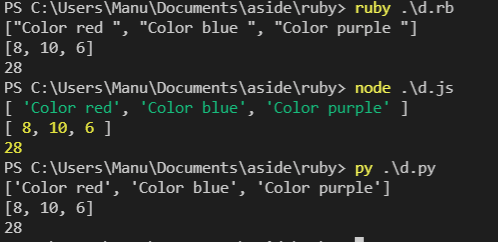When I learn a new language I like to create my own map/filter/reduce functions in it because is a great way to test my skills, working with functions,arrays,functions as arguments,etc.
So now I will compare how I would create it in all of them starting with JavaScript
// Map
function myMap(array,callback) {
newArray=[]
array.forEach(value => newArray.push(callback(value)))
return newArray
}
const transformed = myMap(["red","blue","purple"] , (color) => `Color ${color}`)
console.log(transformed)
//Filter
function myFilter(array,callback) {
newArray=[]
array.forEach(value => callback(value) && newArray.push(value))
return newArray
}
const filtered = myFilter([1,4,8,2,10,6] , number => number > 5)
console.log(filtered)
// Reduce
function myReduce(array,callback) {
let acc = 0
array.forEach(value => acc = callback(acc,value))
return acc
}
const reduced = myReduce([4,5,9,10] , (acc,current) => acc + current)
console.log(reduced)
Let's do it in python now
python is pretty much the same, just using lambdas instead arrow functions
# Map
def myMap(list,callback):
newList=[]
for item in list:
newList.append(callback(item))
return newList
transformed=myMap(["red","blue","purple"],lambda color: "Color " + color)
print(transformed)
#Filter
def myFilter(list,callback):
newList=[]
for item in list:
if callback(item) : newList.append(item)
return newList
filtered= myFilter([1,4,8,2,10,6],lambda number : number>5)
print(filtered)
#Reduce
def myReduce(list,callback):
acum=0
for el in list:
acum=callback(acum,el)
return acum
reduced = myReduce([4,5,9,10] , lambda current,actual:current+actual)
print(reduced)
And now Ruby
Ruby is a little bit more different, you pass blocks that act like anonymous functions, arguments are enclosed in | argname |
and they are called inside the function using the yield word
#Map
def myMap(array)
newarray=[]
for value in array do
result=yield(value)
newarray.push(result)
end
return newarray
end
transformed=myMap(["red","blue","purple"]) do | color | "Color #{color} " end
puts transformed.inspect
# Filter
def myFilter(array)
newarray=[]
for value in array do
newarray.push(value) if yield(value)
end
return newarray
end
filtered = myFilter([1,4,8,2,10,6]) do | number | number > 5 end
puts filtered.inspect
#Reduce
def myReduce(array)
acc = 0
for value in array do
acc = yield(acc,value)
end
return acc
end
reduced = myReduce([4,5,9,10]) do | acc,curr | acc+curr end
puts reduced.inspect
Here is a image that show that all of them have the same result
In general I had a lot of fun learning new things and I think it is such a great thing to do to improve your coding skills.



Top comments (0)